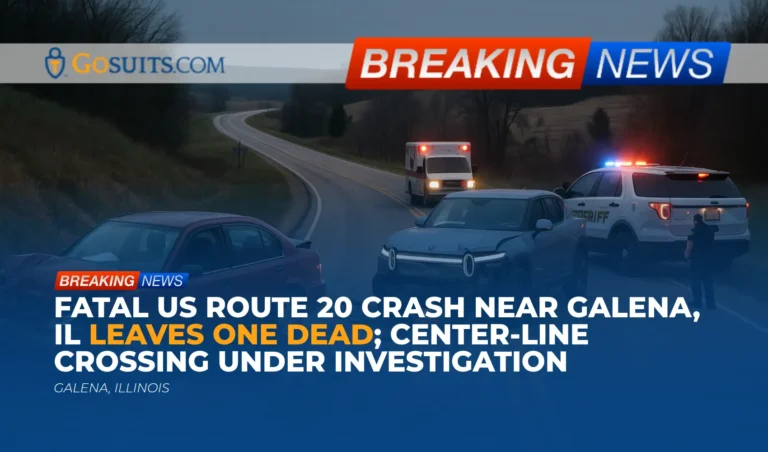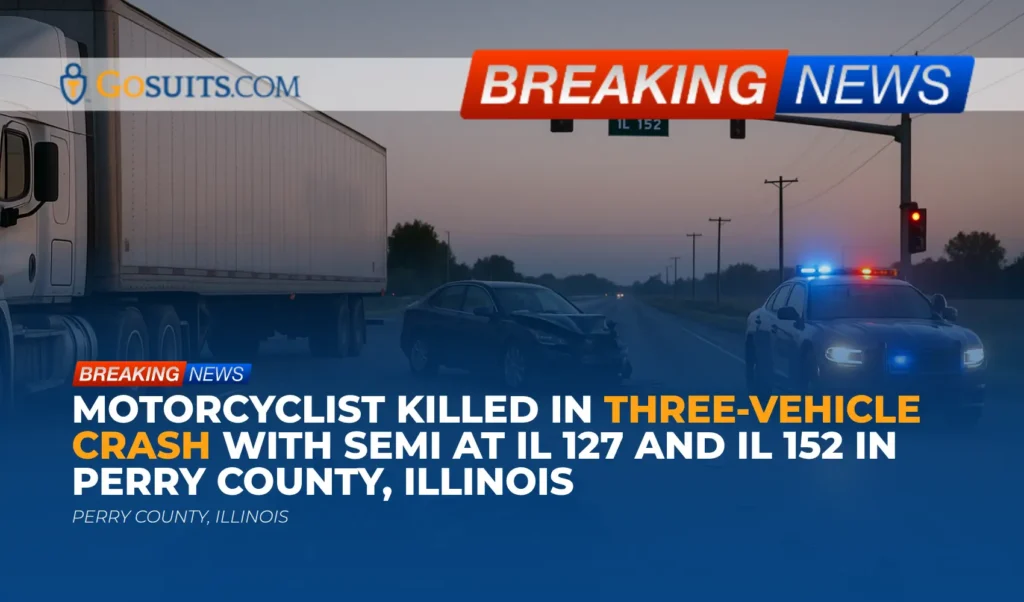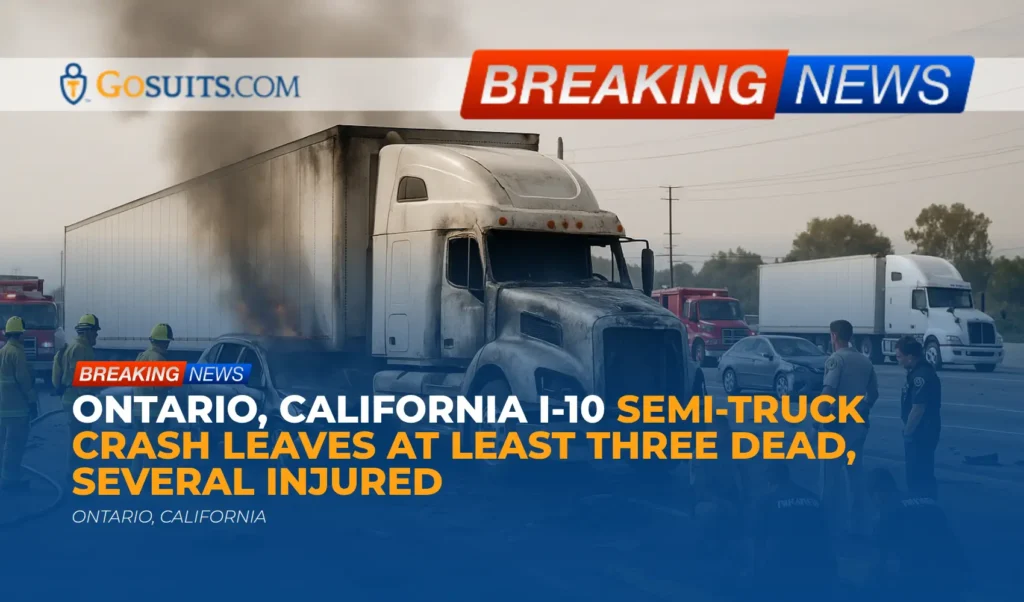- What is known about the fatal crash near Galena, Illinois
- Where and when it happened, and who responded
- How center line crashes are investigated in Illinois
- How families can request key records and documents
- Illinois civil law context after a fatal motor vehicle crash
- Potential civil liability issues in a center line collision
- Insurance considerations for those affected
- Safety context for US Route 20 and rural two‑lane roads
- Compassionate care for survivors and witnesses
- How police investigations interact with civil claims
- Typical timelines for claims and litigation
- Common pitfalls after serious collisions
- Commentary from Gosuits Galena, Illinois Personal Injury Attorney
- Why taking action sooner matters after a serious crash
What is known about the fatal crash near Galena, Illinois
Authorities in Jo Daviess County reported a fatal multi vehicle crash on US Route 20 near Galena on Thursday night. Dispatch received the call at approximately 8:17 p.m. When deputies arrived, they found two involved vehicles, a Chrysler in the ditch and a Rivian blocking the roadway. The Chrysler was driven by 64 year old Aleksandr Avanesov of Benton, Wisconsin. The Rivian was driven by 42 year old Patrick Jung of Galena, Illinois, with passenger Rhea Jung. Mr. Avanesov was transported by ambulance to a local hospital, where he was pronounced deceased. Mr. and Ms. Jung were evaluated at the scene.
According to preliminary information provided to media, investigators believe the Chrysler was traveling westbound on US Route 20 and crossed the center line into eastbound traffic, striking the Rivian. The crash remains under active investigation by local authorities. Additional details such as contributing factors, environmental conditions, and any potential medical or mechanical issues were not available at the time of this writing.
Any loss of life on our roadways is deeply tragic. Our thoughts are with the family of Mr. Avanesov and with those who survived and are coping with the aftermath. Early reports can change as officials complete a full reconstruction, so patience and care are important while facts are established.
Where and when it happened, and who responded
The incident occurred on US Route 20 in the Galena area of Jo Daviess County, Illinois, on a Thursday evening at approximately 8:17 p.m. US 20 is a major corridor in northwestern Illinois with segments of rural, two lane highway where nighttime visibility, curves, grades, and speed differentials can influence crash risk.
Response and initial investigation were handled by the Jo Daviess County Sheriff’s Office. Depending on the severity and needs of the investigation, additional agencies sometimes assist, including regional crash reconstruction teams, state police, and local fire or EMS providers. In fatal collisions, the county coroner is generally notified to determine cause and manner of death under Illinois law.
How center line crashes are investigated in Illinois
In a head on or center line crossing crash, investigators typically work through a methodical process to identify what happened and why. That process often includes:
- Scene documentation Photographs, measurements, and mapping of the roadway, final rest positions, debris fields, fluid trails, yaw marks or skid marks, and any tire or gouge marks. Visibility, signage, lighting, roadway slope, and weather are also considered.
- Vehicle inspections Examination of damage profiles, occupant restraint use, airbag deployments, and potential mechanical issues such as tire condition, steering or braking components, and lighting.
- Witness statements Accounts from involved motorists, passengers, and bystanders. These help corroborate timing, lane positions, and evasive actions.
- Event Data Recorder (EDR) downloads Many modern vehicles record pre crash information such as speed, throttle, brake use, and seatbelt status. The federal EDR regulation at 49 CFR Part 563 describes standardized data elements for many vehicles. Access and use of EDR data are governed by law, and trained personnel typically perform downloads to preserve integrity. See the U.S. Department of Transportation’s regulation at 49 CFR Part 563.
- Toxicology and medical findings In fatal crashes, the coroner may order an autopsy and toxicology. Results can inform whether a medical event or impairment contributed. Illinois coroner duties are established by statute. See the Illinois Counties Code provisions relating to coroners at 55 ILCS 5, Coroners.
Because initial crash summaries are preliminary, final findings may change after full reconstruction, EDR analysis, and laboratory reports are complete. Families and involved drivers can usually request the crash report and, when available, supplemental reconstruction reports through official channels described below.
How families can request key records and documents
Gathering official documents helps families understand what happened and navigate practical matters such as insurance and estate administration. In Illinois, several agencies may hold records connected to a crash. Processes vary by county and agency, but the following guidance and official resources are a reliable starting point.
Police crash report
The Jo Daviess County Sheriff’s Office is the primary investigating agency for this incident. Copies of crash reports are typically available after the report is approved and any necessary redactions are completed. Many Illinois agencies provide copies directly through a Records Division or via an online vendor, while others may direct requesters to the Illinois State Police. The Illinois State Police provides information about obtaining crash reports and records on its official site at isp.illinois.gov. If unsure which portal to use, contacting the Sheriff’s administrative or records office and asking for the procedure to obtain a crash report is appropriate.
For public records generally, Illinois has a statewide Freedom of Information Act that governs access to many governmental records, including certain crash related materials. See 5 ILCS 140, Freedom of Information Act. Law enforcement may withhold or delay release of some documents if release would interfere with an active investigation, but basic crash reports are routinely released.
Coroner and autopsy materials
If the county coroner has jurisdiction in a death, the office may maintain records including autopsy reports, toxicology reports, and determinations of cause and manner of death. Access to coroner records is governed by Illinois law and may require proof of relationship or legal standing. Statutory duties and procedures for coroners are summarized in the Illinois Counties Code at 55 ILCS 5, Coroners. Families may contact the Jo Daviess County coroner to ask about availability and request procedures once the examination is complete.
Death certificates
Certified death certificates are issued through Illinois vital records. The Illinois Department of Public Health provides information on how to obtain death certificates at dph.illinois.gov/topics-services/birth-death-other-records. A funeral director often helps initiate the filing, and certified copies can be ordered through the county clerk or through IDPH. Certified copies are commonly needed for insurance, financial accounts, and estate matters.
Emergency medical and hospital records
Emergency responders and hospital providers generate records of care. For a deceased person, access typically requires an executor, administrator, or other legally authorized representative. Providers will usually ask for documentation such as letters of office or a small estate affidavit.
Vehicle preservation and data
If vehicles are impounded or stored at a tow yard, prompt written requests can help preserve physical evidence and electronic data. Formal preservation letters seeking to prevent disposal or alteration are commonly used. Because many modern vehicles contain EDR data, requesting that data be preserved and not downloaded without notice can be important. Federal guidance on EDR data elements is at 49 CFR Part 563.
Illinois civil law context after a fatal motor vehicle crash
When a fatal collision occurs, two Illinois statutes are frequently relevant from a civil perspective. This is general information only.
- Wrongful Death Act Illinois permits a civil wrongful death action for the benefit of the surviving next of kin. Damages are for losses suffered by survivors, such as loss of society and certain pecuniary losses. See 740 ILCS 180.
- Survival Act Certain claims the decedent could have brought, such as for conscious pain and suffering and medical expenses before death, may survive to the estate. See 755 ILCS 5/27-6.
Statutes of limitation set filing deadlines, and they can vary based on circumstances, the identity of defendants, and other factors. Families often appoint a personal representative through the probate court to handle estate matters and to pursue, defend, or resolve claims.

Potential civil liability issues in a center line collision
Crossing the center line into oncoming traffic is often a critical fact in determining fault in a head on collision. However, civil responsibility can depend on a thorough evaluation of all contributing factors. The investigation typically considers:
- Driver conduct Lane position, speed, following distance, and attentiveness in the seconds leading to the crash.
- Medical emergencies A sudden, unforeseeable medical event can be raised as a defense in some cases, but this depends on credible medical evidence and whether the condition was foreseeable.
- Mechanical issues Tire blowouts, steering or brake failures, or lighting malfunctions can contribute. Preservation and inspection are crucial.
- Roadway environment Sight lines, surface conditions, temporary lane shifts, or inadequate markings. If public roadway conditions are implicated, additional notice requirements and immunities may be at issue.
- Comparative fault Illinois follows modified comparative negligence. Under 735 ILCS 5/2-1116, a claimant’s damages can be reduced by their percentage of fault, and recovery is barred if the claimant is more than 50 percent at fault. This allocation can matter when multiple drivers and claimants are involved.
It is important not to draw conclusions before the reconstruction is complete. Final liability assessments require the complete evidentiary record, including electronic data, medical findings, and scene analysis.
Insurance considerations for those affected
Insurance issues after a serious crash can be complex, especially where there is a fatality and multiple parties. The following considerations commonly arise. This is general information and not specific advice.
- Liability coverage The at fault driver’s liability insurance is typically primary for bodily injury and property damage claims by others. When fault is disputed, insurers may conduct their own investigation and request statements.
- Uninsured or underinsured motorist coverage If the at fault driver lacks adequate coverage, injured people in the other vehicle may present claims under their own UM or UIM coverage. Policy terms vary, including notice and consent to settle provisions.
- Medical payments coverage Some policies include MedPay that can help with initial medical bills regardless of fault. Payments may be subject to subrogation or coordination of benefits.
- Estate and probate interface Where the at fault driver is deceased, claims may be presented to the estate. Timely opening of an estate and appointment of a representative can be necessary both for presenting claims and for defending them.
- Recorded statements and authorizations Statements given to insurers are evidence that can be used later. Before speaking to any insurance company or signing medical or broad record authorizations, consulting an attorney is prudent. What is said early on can affect later outcomes.
- Policy limits and multiple claimants When several people are injured or there is a fatality, limited policy limits can create conflicts. Coordinating claims strategically and evaluating all potentially responsible parties can be important.
Because insurance adjusters work for the carrier, not for families, independent guidance helps balance the process. It is generally advisable to speak with a qualified attorney before contacting insurers, and to seek a free consultation to understand rights and obligations.
Safety context for US Route 20 and rural two‑lane roads
Rural, two lane highways like portions of US Route 20 carry elevated risk for severe injury when vehicles cross the center line. Federal transportation safety resources consistently note that lane departure and head on crashes on rural roads are a significant source of fatalities relative to traffic volume.
- Rural roadway risk The Federal Highway Administration highlights that rural roads, while carrying a smaller share of total traffic, account for a disproportionate share of roadway fatalities. See FHWA’s rural safety materials at safety.fhwa.dot.gov/rural.
- Countermeasures Proven strategies to reduce center line crossings include center line rumble strips, shoulder rumble strips, high visibility markings, and targeted enforcement. FHWA’s safety programs describe these countermeasures and their effectiveness at safety.fhwa.dot.gov.
- Data and trends National crash data from the National Highway Traffic Safety Administration’s Fatality Analysis Reporting System provides detailed insights into the prevalence and severity of head on and lane departure crashes. See NHTSA FARS.
These broader safety points do not assign responsibility in this specific crash, but they provide context for why nighttime, two lane rural corridors need careful attention to lane position, speed, and visibility.
Compassionate care for survivors and witnesses
Serious crashes are traumatic for everyone involved, including witnesses and first responders. It is common to experience stress reactions such as sleep disturbance, anxiety, sadness, or intrusive memories. Support can help. The Substance Abuse and Mental Health Services Administration provides a 24 7 helpline that can connect people with local mental health resources at samhsa.gov/find-help/national-helpline.
Medical evaluation is also important, even if symptoms seem minor at the scene. Some injuries emerge or worsen in the days after a collision. Keeping copies of discharge instructions, imaging, bills, and time off work records will be helpful for any insurance claim.
How police investigations interact with civil claims
Law enforcement investigations focus on determining what happened, documenting evidence, and, where applicable, referring matters within the justice system. Civil claims are separate and focus on compensating for harms and losses caused by another’s negligence or wrongful conduct. The two processes often run in parallel and can share some common evidence, such as scene photos, measurements, and EDR data.
A civil claim does not depend on whether any citation is issued. Civil liability is based on the preponderance of the evidence and can consider factors not part of a traffic citation decision. Preserving evidence early, before vehicles are destroyed or roadway conditions change, is often the most critical step in protecting civil rights.
Typical timelines for claims and litigation
Each case proceeds at its own pace, but several milestones are common:
- First 30 to 90 days Collection of crash reports, photographs, 911 audio, and initial medical records. Vehicle inspections and EDR downloads usually occur during this period.
- 90 to 180 days Completion of coroner findings and toxicology in many cases, though some laboratories require more time. Ongoing medical treatment and documentation for injured survivors.
- Insurance claim phase Presentation of claims to liability and UM or UIM insurers. If policy limits are inadequate or fault is contested, litigation may be considered.
- Litigation If a lawsuit is filed, discovery typically spans many months, including depositions, expert analysis, and motion practice. Some cases resolve through settlement conferences, while others proceed to trial.
Statutes of limitation and notice rules apply, particularly if potential claims involve a governmental entity. Because these deadlines can be complex and fact dependent, many families choose to consult an attorney promptly to identify applicable time limits.
Common pitfalls after serious collisions
- Providing statements too soon Insurance adjusters may seek recorded statements early. Statements can be used later and may omit important context. Consulting an attorney first can prevent misunderstandings.
- Signing broad authorizations Overly broad medical or employment authorizations can allow unnecessary access to private history. Tailored, time limited authorizations are usually preferable.
- Letting vehicles be destroyed Early release of a totaled vehicle can erase critical evidence. A written preservation request can prevent disposal until inspections and downloads are complete.
- Missing documents Not obtaining the crash report, coroner findings, and medical records can stall claims. Start record requests early.
- Overlooking UM or UIM coverage Many households carry UM or UIM coverage without realizing it. Reviewing all policies, including resident relative policies, is prudent.
Commentary from Gosuits Galena, Illinois Personal Injury Attorney
Our hearts go out to the family and loved ones of Mr. Avanesov and to the survivors who endured this frightening event on US Route 20. This article is intended for educational purposes and general information. As details develop, the focus should remain on compassion, truth finding, and practical support for all involved.
From a civil injury standpoint, a center line crossing on a rural, two lane roadway is a red flag for investigators. The key questions are always what led to the lane departure and whether any combination of driver factors, vehicle issues, or roadway conditions played a role. Only a complete investigation, including scene data, vehicle inspections, and relevant medical findings, can answer those questions fairly.
In the weeks after a serious crash, insurance carriers and corporate actors often move quickly. Adjusters may request recorded statements, broad medical authorizations, or early vehicle releases. Those requests can be framed as routine, but they can also place families at a disadvantage by locking in statements before the evidence is fully known or by limiting access to critical vehicle data. When multiple claims are competing against limited policy limits, early missteps can have outsized consequences.
Obtaining a free consultation with a skilled attorney before engaging with insurers is a practical way to understand rights, identify evidence that should be preserved, and map out a plan that protects the interests of those affected. It also helps reduce the stress of navigating deadlines, documents, and technical questions while grieving or recovering.

Why taking action sooner matters after a serious crash
In the aftermath of a significant collision, certain steps are time sensitive and can influence outcomes for everyone involved. Acting promptly helps preserve evidence, protects legal rights under Illinois law, and supports informed decision making. The following actions are commonly important:
- Request essential records Obtain the police crash report, later any supplemental reconstruction, and relevant coroner documents once available. These materials anchor the factual understanding of what happened.
- Preserve the vehicles and data Ensure involved vehicles are not destroyed or altered before qualified inspections and EDR downloads occur. Written preservation requests to tow yards, insurers, and any storage facilities are often necessary.
- Organize medical documentation Keep all discharge summaries, imaging, prescriptions, and invoices in one place. Consistent documentation supports accurate assessment of injuries and losses.
- Be cautious with insurers Before giving any recorded statement or signing broad authorizations, consult an attorney. Statements can be used later, and early releases of vehicles can compromise evidence.
- Identify coverage Review auto policies for liability, medical payments, and UM or UIM provisions. Consider policies held by household members if applicable. Knowing available coverage informs strategy when multiple claims are involved.
- Track deadlines Statutes of limitation and special notice rules can apply, especially if a public entity is potentially involved. Understanding and calendarizing these deadlines reduces the risk of forfeiting claims.
- Consider support services Access mental health resources and victim support programs as needed. Emotional and practical support can make the process more manageable.
Taking these steps earlier rather than later helps ensure that critical evidence is not lost, that insurance interactions are handled thoughtfully, and that applicable deadlines are met. Consulting an attorney first, and obtaining a free consultation, allows individuals to understand their rights and responsibilities before making decisions that could affect their claims.
Additional official resources cited in this article
The following government resources provide authoritative information on topics discussed above. They are not specific to this crash but offer helpful background:
- 49 CFR Part 563, Event Data Recorders U.S. Department of Transportation regulation describing standardized EDR data elements.
- Illinois Wrongful Death Act, 740 ILCS 180 General framework for wrongful death actions.
- Illinois Survival Act, 755 ILCS 5/27-6 Survival of certain causes of action to the estate.
- Illinois modified comparative negligence, 735 ILCS 5/2-1116 Fault allocation in civil cases.
- Coroner provisions, 55 ILCS 5 Duties and records of coroners.
- Illinois Freedom of Information Act, 5 ILCS 140 Public records access.
- Illinois Department of Public Health Vital Records Death certificate information.
- Illinois State Police General portal for statewide law enforcement services, including records information.
- FHWA Rural Road Safety Risk factors and countermeasures on rural roads.
- NHTSA FARS National fatal crash data.
- SAMHSA National Helpline 24 7 mental health and substance use support.






